Search results for: 'stone of'
-
 Paleolithic hand axe
Paleolithic hand axePrehistoric stone tool. It was the universal tool of the older Stone age and could be used as a borer or a cutter. From a Swiss museum collection. Found in Algeria, North Africa.
Price: on request Paleolithic hand axe
Paleolithic hand axePrehistoric stone tool. It was the universal tool of the older Stone age and could be used as a borer or a cutter. From a Swiss museum collection. Found in Morocco, North Africa.
Price: on request Huge Paleolithic hand axe
Huge Paleolithic hand axePrehistoric stone tool. It was the universal tool of the older Stone age and could be used as a borer or a cutter. From a Swiss museum collection. Found in Morocco, North Africa.
Price: on request Paleolithic hand axe
Paleolithic hand axePrehistoric stone tool. It was the universal tool of the older Stone age and could be used as a borer or a cutter. From a Swiss museum collection. Found in Morocco, North Africa.
Price: on request Large prehistoric hand axe
Large prehistoric hand axeMassive Paleolithic stone tool. It was the universal tool of the older Stone age and could be used as a borer or a cutter. From a Swiss museum collection. Found in Algeria, North Africa.
Price: on request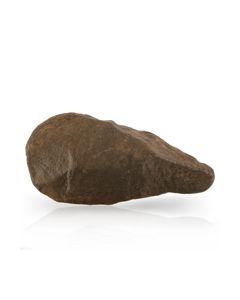 Paleolithic hand axe
Paleolithic hand axePrehistoric stone tool. It was the universal tool of the older Stone age and could be used as a borer or a cutter. From a Swiss museum collection. Found in the Algerian Sahara desert.
Price: on request Paleolithic hand axe
Paleolithic hand axePrehistoric stone tool. It was the universal tool of the older Stone age and could be used as a borer or a cutter. From a Swiss museum collection. Found in the Algerian Sahara desert.
Price: on request Large Paleolithic hand axe
Large Paleolithic hand axePrehistoric stone tool. It was the universal tool of the older Stone age and could be used as a borer or a cutter. From a Swiss museum collection. Found in Foggaret Ezzaouia, Algeria, North Africa.
Price: on request Paleolithic hand axe
Paleolithic hand axePrehistoric stone tool. It was the universal tool of the older Stone age and could be used as a borer or a cutter. From a Swiss museum collection. Found in Erg Mehedjibat, Algeria, North Africa.
Price: on request Large Paleolithic hand axe
Large Paleolithic hand axePrehistoric stone tool. It was the universal tool of the older Stone age and could be used as a borer or a cutter. From a Swiss museum collection. Found in Erg Mehedjibat, Algeria, North Africa.
Price: on request Paleolithic hand axe
Paleolithic hand axePrehistoric stone tool. It was the universal tool of the older Stone age and could be used as a borer or a cutter. From a Swiss museum collection. Found in Erg Mehedjibat, Algeria, North Africa.
Price: on request Six neolithic stone tools
Six neolithic stone toolsNice group of artefacts from the Northern European Neolithic. One blade, two dagger fragments and three axe head fragments. All found in Northern Germany.
Price: on request Stone Age chisel from Northern Germany
Stone Age chisel from Northern GermanyAsymmetrically shaped chisel with two polished sides. Made of light flint. Approx. 3400 to 2400 BC.
Price: on request Paleolithic hand axe or borer
Paleolithic hand axe or borerPrehistoric stone tool. It was the universal tool of the older Stone age and could be used as a borer or chisel. From a Swiss museum collection. Found in the Algerian Sahara desert.
Price: on request Stone Age bow scraper from Egypt
Stone Age bow scraper from EgyptThe Paleolithic tool is of beautiful shape and color. Thebes has been handed down as the place of origin. Including old museum display.
Price: on request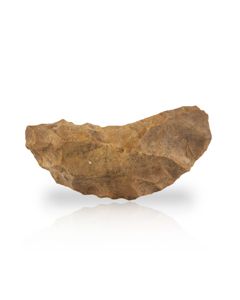 Stone Age bow scraper from Egypt
Stone Age bow scraper from EgyptThe Paleolithic tool is shaped like a sickle. Thebes has been handed down as the place of origin. From a 100 year old museum collection.
Price: on request Stone Age bow scraper from Egypt
Stone Age bow scraper from EgyptThe Paleolithic tool is of beautiful shape and color. Thebes has been handed down as the place of origin. From an old museum collection.
Price: on request Neolithic axe head
Neolithic axe headThe strong blade was probably used for a battle axe. Crafted from grey rock. An artefact from the Neolithic Age of Europe.
€490 Neolithic flint dagger from Denmark
Neolithic flint dagger from DenmarkDouble-edged blade and flat shaft made of beautiful flintstone. A status symbol from the transitional period between Late Neolithic and Early Bronze Age.
€480 Neolithic flint dagger from Denmark
Neolithic flint dagger from DenmarkDouble-edged blade and flat shaft made of beautiful flintstone. A status symbol from the transitional period between Late Neolithic and Early Bronze Age.
Price: on request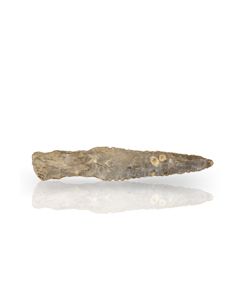 Neolithic flint dagger from Denmark
Neolithic flint dagger from DenmarkDouble-edged blade and flat shaft made of beautiful flintstone. A status symbol from the transitional period between Late Neolithic and Early Bronze Age.
€650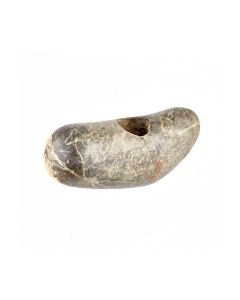 Finely polished hammer axe
Finely polished hammer axeThe compact axe head is made of beautiful and polished green-black stone with white veins. Late Neolithic to Copper Age.
Price: on request Neolithic dagger blade from Denmark
Neolithic dagger blade from DenmarkDouble-edged, pointed blade made of beautiful flint. The blade was for a dagger, the typical status symbol from the transitional period between Late Neolithic and Early Bronze Age.
€480 Neolithic dagger blade from Denmark
Neolithic dagger blade from DenmarkDouble-edged, pointed blade made of beautiful flint. The blade was for a dagger, the typical status symbol from the transitional period between Late Neolithic and Early Bronze Age.
€470 Neolithic axe head from Luetzow in Northern Germany
Neolithic axe head from Luetzow in Northern GermanyPolished axe made of beautiful brown flint. It was found more than 100 years ago near the town of Luetzow.
Price: on request Powerful and heavy work axe
Powerful and heavy work axeRare and impressively large and heavy tool from the New Stone Age. The axe type comes from Jutland, Denmark.
Price: on request Neolithic sickle from Denmark
Neolithic sickle from DenmarkCrescent-shaped blade made of beautiful brown flint. This tool represents an intermediate state within the radical transition from Neolithic to Bronze Age.
€700 Neolithic flint sickle from Denmark
Neolithic flint sickle from DenmarkCrescent-shaped blade made of beautiful brown flintstone. This tool represents an intermediate state within the radical transition from Neolithic to Bronze Age.
€530 Neolithic flint sickle from Denmark
Neolithic flint sickle from DenmarkCrescent-shaped blade made of beautiful reddish-brown flintstone. This tool represents an intermediate state within the radical transition from Neolithic to Bronze Age.
€520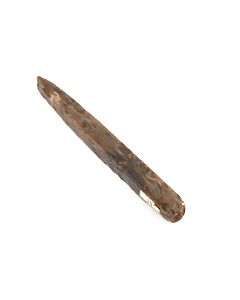 Neolithic chisel from Northern Germany
Neolithic chisel from Northern GermanyElegantly shaped chisel with two polished sides. Made of dark flint. Approx. 3400 to 2400 BC.
Price: on request Paleolithic hand axe of Homo Erectus
Paleolithic hand axe of Homo ErectusBig hand axe from Niger. Made during the Old Stone Age, around 200,000 years ago. The universal stone age tool could be use as a borer or cutting tool.
Price: on request Three neolithic arrowheads from Egypt
Three neolithic arrowheads from EgyptThe Stone Age points are beautifully crafted, with finely serrated edges. From a 100 year old museum collection.
Price: on request Restbestand - 283 Perlen aus dem Neolithikum zu stark reduziertem Preis
Restbestand - 283 Perlen aus dem Neolithikum zu stark reduziertem PreisIdeal für Gestaltung zu Ketten oder als Händlerlot geeignet. Ounjougou-Kultur, westliche Sahara. Ca. 5000 bis 3000 v.Chr, Neolithikum.
Price: on request Three neolithic arrowheads from Egypt
Three neolithic arrowheads from EgyptThe Stone Age points are beautifully crafted, with finely serrated edges. From a 100 year old museum collection.
Price: on request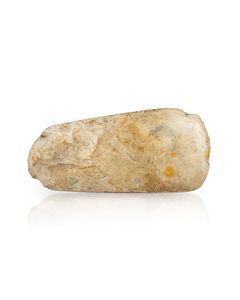 Neolithic axe head
Neolithic axe headA Stone Age tool from Aalborg in Denmark. Nicely polished and impressive workmanship.
Price: on request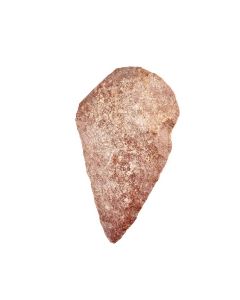 Paleolithic hand axe
Paleolithic hand axeThe universal tool of the older Stone age. It could be used as a borer or a cutter. Approx. 500,000 to 200,000 BC.
Price: on request

